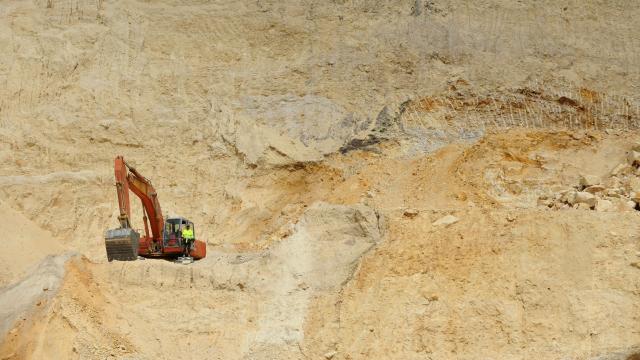The world consumes gargantuan quantities of sand for all kinds of things, which along with related materials like gravel and crushed rock, accounts for 85% of all mineral extraction on Earth. A new study details the massive environmental toll it takes — and how we can fix it.
The new study, published in One Earth on Friday, looks at the world’s extensive sand supply chain. The authors, who come from hard and social science backgrounds, employed a buzzy, holistic framework called telecoupling, which allowed them to look at the interaction between socioeconomic and environmental factors.
“We take a broad look at the physical and socio-environmental dimensions of sand supply networks — linking extraction, logistics, distribution, economics, policy — to gain an understanding of the stresses on both nature and people,” research associate Aurora Torres at Michigan State University’s fisheries and wildlife school and lead author of the study, wrote in an email.
She noted the world uses “around [45.3 billion tonnes] of sand, gravel, and crushed rock to produce concrete for our houses and to build roads and infrastructure.” But sand is also a source of other essential products, including refining quartz sand to make silica that goes into everything from windows to vaccine vials to microprocessors that power our laptops and solar panels. Some kinds of sand are also used in fracking to hold open cracks deep underground to pull out fossil fuels.
Since sand supply is poorly regulated and managed, there’s not much data on all that activity, so we don’t have exact numbers on how much of it we use. But what is clear is that demand for sand for all these uses is increasing rapidly, which is creating huge problems. In fact, over the next 30 years, eight cities the size of New York will be built each year, the study says.
“Sand and gravel are the world’s most extracted solid materials by mass and their annual consumption is predicted to double by 2060,” said Torres. “This situation is putting pressure on threatened ecosystems, triggering social conflicts, and fuelling concerns over sand shortages.”
Increasing extraction, the authors write, will make these issues all the more severe and lead them to compound. For instance, the study says, sand can lead to riverbed collapse and erosion in coastal communities. That means affected populations in places like India and Vietnam may be pushed to migrate inland toward cities, which could in turn lead to increased demand for sand for development. This very process played out in 2016 after Cyclone Winston hit Fiji, according to the study.
Environmental stress from sand mining can also increase the risk of conflict and economic peril. Sand mining has triggered land grabs in places like Singapore. And throughout Southeast Asia, sand smuggling is a dangerous black market. Dangerous sand mining gangs have depleted enough sand to cause 24 Indonesian islands to disappear as a result of erosion. Again, this can all force people to flee to cities, increasing sand demand.
Decreasing the global use of sand is also an important climate mitigation strategy, the study says, because sand is most often used to create carbon-intensive products like cement.
“Urban population growth and associated infrastructure development may claim the entire carbon budget of a 2 degree Celsius [3.6 degree Fahrenheit] warming limit by mid-century,” the authors write. They go on to note that if developing countries’ building stock reaches levels of developed ones, producing raw materials alone would eat up anywhere from 35% to 60% of the carbon budget.
To mitigate all these issues, the authors say, we should more carefully monitor and manage our sand resources. One key strategy is to use alternatives when possible. For instance, sand can be artificially created by crushing rock, which can be far more sustainable. The authors note that this fake sand is already a major export commodity for some countries, especially Norway, and a major source of sand for construction in the U.S. and China.
Recycling could also ward off our sand crises. For instance, when new buildings replace demolished ones, governments could require construction companies to process and reuse the rubble instead of laying new concrete. More sustainable alternatives to sand-based construction materials, including hempcrete and sustainably sourced timber, could also play a role. All this will require some serious regulation — it won’t happen if it’s left up to market forces, because concrete is currently quite cheap to produce despite its environmental toll.
This should all be coupled with attempts to lessen demand overall. For instance, developers should be encouraged to construct buildings that will last a long time and reduce the unnecessary overuse of sand.
“If we continue increasing our consumption of sand, that will not only cause significant impacts from mining in terms of destroying ecosystems, compromising the supply of ecosystem services, and triggering social unrest,” said Torres. The world could also simply run out of sand to use. There’s an incomprehensible amount of it on the planet — some 7.5 quintillion grains — and yet we’re still facing a shortage. We can’t allow ourselves to fall into a sand trap.
